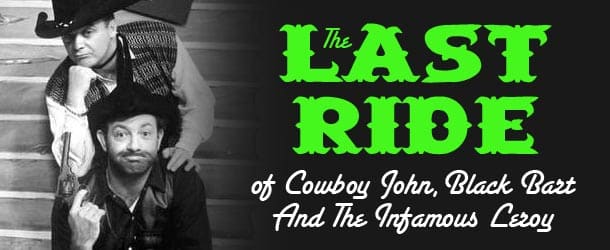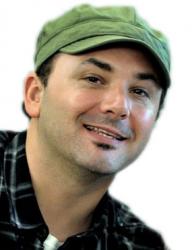By Todd C. Elliott
Nothing lassoed kiddies of the “baby boom” generation like television.
Southwest Louisiana children wrangled around their TV sets six days a week to catch a small, Port Arthur-based, NBC-affiliate TV station with the call letters KPAC. Kids tuned in from 1957 to 1972 for the Circle 4 Club to watch the antics of station weatherman John Garner as he portrayed Cowboy John. Cowboy John was like a god to kids of the late 1950s and early 1960s.
First of all, Cowboy John was on television. He was like a real life Lone Ranger who spoke to children and had 25 to 30 kids “circle their wagons” around him on the show as a live studio audience.
Every hero has a nemesis. And Cowboy John had Black Bart, who was portrayed by Johnny Stevens of Port Arthur.
In between episodes of The Three Stooges and The Little Rascals, Black Bart would take a kicking in the shin from Cowboy John as the make-believe villain was thwarted and order was restored, with laughter and entertainment, to the world — and the delight of the kids.
My mother informed me that, as a child growing up in Lake Charles during the early sixties, her first crush was on Cowboy John. She loved him (and still does).
However, today, as he rides into his sunset, “Cowboy” John Garner, of Port Arthur, sees a forecast of dark clouds on the horizon.
Garner said in a interview with Lagniappe Magazine that he was diagnosed with pancreatic cancer about four months ago.
But he took the time to shoot the breeze with a pesky media person by phone. I informed him that Cowboy John had a large fan following in Lake Charles. I told him that I’ve never seen his show and he told me I never would.
“Back then, we didn’t have any means to tape,” said Garner. “What tape we did, because it was so experimental, really, we did for commercials and for the news. They had priority, naturally. And it was expensive. Those tapes were really expensive for us.”
As the show was cheaper to do live, the only records of Cowboy John’s cavalcade surface in the form of still photographs and dusty memories of thousands in Southeast Texas and Southwest Louisiana. The thrill of live television fanned the flames of the kids who knew they would be on television.
Garner said that for six days a week, something unexpected usually happened every episode. However, one day in particular would forever be remembered because of the unexpected.
At a pivotal time in American history, desegregation came, integration came, and an 8-year-old named Leroy came into the studio on a special day at the television studio, as the station hosted “colored day” for boys and girls of the black community. Garner said “everybody” seemed to be watching that day in particular.
“I knew people that were doctors and lawyers, at the time, that said to me that they were watching that day,” said Garner. “The touchy part about this whole story is that we were still segregated. I had to be very careful.”
Garner said that as the television show was broadcast to thousands of TV sets across Southeast Texas and Southwest Louisiana, Cowboy John noticed that a little black girl, who was probably about six, “busted out laughing” on the set. “I knew something had happened,” said Garner. “So, I naturally pressed it like an idiot. And I asked this little girl, I said, ‘tell me what ya’ll are laughing about,’ which made her laugh even more.”
“I can’t tell you,” said the little black girl.
Cowboy John kept on. He implored and begged the little girl to tell him what was so darn funny. “Well …” said the little girl in the audience of kids. “Leroy farted!” Her diminutive Southern accent caused raucous laughter from all the kids on the live show.
Accounts may differ, but some viewers of the program claimed that the “f” word, which was followed by the howling and cackling of children, caused the television camera to pan wildly, as it seemed to ricochet like an imaginary bullet from Cowboy John himself. “I just started stuttering and stammering,” said Garner.
Perhaps sweat began to bead on Cowboy John’s brow as the camera searched for a way out of the show and into the saving graces of a commercial break. Ever the showman and professional, Cowboy John wasn’t about to let this stampede of laughter and the unexpected twist railroad his show.
With his microphone in hand, Cowboy John quickly went to the next child, a young boy sitting next to this little girl. This boy would surely be the show’s saving grace.
“And what’s your name, partner?” Cowboy John asked.
“I’s Leroy!” the boy said.
Laughter erupted again and sent the camera into wild spiraling again, perhaps from laughter or hope of escape.
“Of course the little boy next to her was Leroy,” Garner said. “I really didn’t know how to handle it.”
Now the story can be told for the first time in an official capacity. For years, newspapers and publications wouldn’t print it because of the use of the “f” word: fart. I figured that if it was good enough for live television, it was good enough for Lagniappe Magazine.
The story and legend of “Leroy farted” blew up overnight. It went viral. It was the equivalent of modern viral video but without the video. That night on The Huntley-Brinkley Report, which featured NBC news giants Chet Huntley in New York and David Brinkley in Washington, D.C., the tale of Leroy made it to one of the earpieces. Many claimed that as the anchormen signed off that evening, David Brinkley said on live, national television, “And goodnight Leroy in Port Arthur, Texas!”

Cowboy John and Black Bart with Joan Crawford at the grand opening of the Pepsi plant in Beaumont circa 1967.
Many claimed that Brinkley was the one with the sense of humor and would have gotten a kick out of the report. However, Garner said that Chet Huntley made the sign off that night. Whoever said it, I wonder how these two guys, who provided the commentary for the historic Apollo moon landing for NBC, heard of the Leroy incident.
Garner said the station manager of KPAC had once worked with, and remained friends with, the assistant producer of NBC News. Garner said the story went viral from Port Arthur straight into the news rooms and the imagination of news executives in Washington, D.C. and New York. Like a joke, it must have been repeated until it was told to either Huntley or Brinkley. Perhaps they even thought it was a joke.
But it was real, and so was Leroy. But Leroy who? Who was this mysterious Leroy, whose flatulence had taken his name to the next level, a bigger market and then nationwide into NBC News?
From there, Leroy was the stuff of flatulent legend. “I met a fellow that claimed to be Leroy; actually a few people have claimed to be Leroy or have claimed to be on the show that day,” Garner said. “The one that I think was Leroy, I spoke with him two or three times. He was then grown. He was way overweight, fat, you know, and jolly. He thought that was the greatest thing that ever happened to him; that it made him famous, you know.”
Garner said that Leroy worked at the Texaco refinery in Port Arthur, where he retired after putting in 20 years. After retiring, Leroy found time to go by the TV station one more time to see old Cowboy John Garner, who was still working for KPAC-TV. Two legends had coffee one day.
“He was a nice, nice guy,” Garner said. “He wasn’t offended by it at all. He’s the one that did it, you know. But he thought it was a funny thing.”
Garner couldn’t remember Leroy’s last name. Garner was concerned with the racial tension at the time and how, many years later, many in the black community looked back at the retelling of the story as a racist joke. At the time of the incident, Leroy innocently used his Southern pronunciation of the phrase “I is Leroy,” with the words “I” and “is” contracted into “I’s,” which was pronounced as “eyes.”
Leroy didn’t think it was racist, according to Garner. Leroy thought it was funny. Leroy thought it was great. It was. Perhaps it was the agitation of a broadcast professional in the new medium of live television. Perhaps it was the innocence of children and the rudimentary, basic humor that makes us human. Perhaps it was the reaction of the real, live studio broadcast laughter, which can be imagined and remastered by our imagination to make it sound better and more infectious than the laughter of children can be.
Perhaps in these moments, the people of the early 1960s transcended their daily, human hang-ups like race, prejudice, bigotry, class and broadcast ratings. All these worrisome things seemed to dissipate for a brief moment with a genuine belly laugh.
I asked Garner about “Black Bart,” his cohort and nemesis — Johnny Stevens of Port Arthur. Cowboy John told me that Black Bart had paid a visit to him just the day before, as he does “a couple of times a week” to check on his old rival.
There’s something allegorical in the tale of Garner and Stevens, who were more than broadcasters and actors; they were friends.
But in the world that they created — which was the original virtual reality for children of the 1960s — there’s the idea of the bad guy, dressed in black, and the good guy, dressed in white. What has been hidden from audiences is the gray of the aging hero and the aging villain, both now comforting one another in the final days of their last ride into the great unknown and starry night.
Goodnight to Cowboy John, goodnight to Black Bart and goodnight to Leroy in Port Arthur.
This article originally appeared in the June 6, 2013 edition of Lagniappe Magazine.

















Comments are closed.